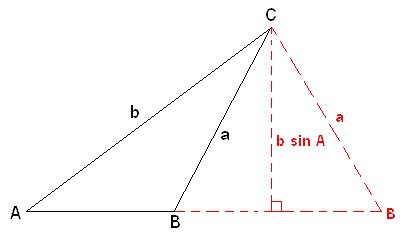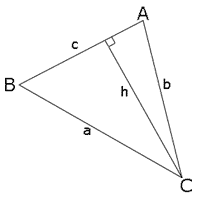Law of sines: Difference between revisions
the previous ones were equivalent equations |
|||
| Line 83: | Line 83: | ||
Or another example of how to solve a problem using the law of sines: |
Or another example of how to solve a problem using the law of sines: |
||
Suck my balls BITCH, the [[chord]], is given as 100' (30.48 m) and the angle ''C'' '''''opposite''''' to the chord is given in '''''degrees''''', then angle ''A'' = angle ''B'' = :<math>{(180-C) \over 2}</math> and |
|||
:<math>{R \over \sin A}={\mbox{chord} \over \sin C}\,</math> '''''or''''' <math>{R \over \sin B}={\mbox{chord} \over \sin C}\,</math> |
:<math>{R \over \sin A}={\mbox{chord} \over \sin C}\,</math> '''''or''''' <math>{R \over \sin B}={\mbox{chord} \over \sin C}\,</math> |
||
Revision as of 16:50, 30 November 2006
In trigonometry, the law of sines (or sine law) is a statement about arbitrary triangles in the plane. If the sides of the triangle are a, b and c and the angles opposite those sides are A, B and C, then the law of sines states:
where R is the radius of the triangle's circumcircle. This formula is useful to compute the remaining sides of a triangle if two angles and a side are known, a common problem in the technique of triangulation. It can also be used when two sides and one of the non-enclosed angles are known; in this case, the formula may give two possible values for the enclosed angle. When this happens, often only one result will cause all angles to be less than 180°; in other cases, there are two valid solutions to the triangle (see the ambiguous case section of this article for further information).
It can be shown that:
where s is the semi-perimeter,
The ambiguous case
When using the law of sines to solve triangles, under special conditions there exists an ambiguous case where two separate triangles can be constructed (i.e., there are two different possible solutions to the triangle).
Given a general triangle ABC, the following conditions would need to be fulfilled for the case to be ambiguous:
- The only information known about the triangle is the angle A and the sides a and b, where the angle A is not the included angle of the two sides (in the above image it isn't, the angle C is the included angle).
- The angle A is acute (i.e., A < 90°).
- The side a is shorter than the side b (i.e., a < b).
- The angle B is not a right angle (i.e., a > b sin A).
Given all of the above premises are true, the angle B may be acute or obtuse; meaning, one of the following is true:
OR
Derivation
Make a triangle with the sides a, b, and c, and angles A, B, and C. Draw a line from the angle C to the side across c so that it divides the original triangle into two right angle triangles. Mark the length of this line h.
It can be observed that:
- and
Therefore:
and
Doing the same thing with the line drawn between angle A and side a will yield:
Full proof:
Make a triangle ABC with sides a, b, c and the γ angle at C. Make an axis through the center of b and another through the c side. Mark the point of intersection of the axis S. Draw a circle k with its center in S with the radius r = |SA| = |SB| = |SC| (the Circumcircle). Through the medial angle law, the angle at S is 2*γ.
Thus, it can be observed that:
or:
and then
Applying cyclic permutation:
- (č.b.t.d)
Examples
Here is an example of how to solve a problem using the law of sines:
Given: side a = 10, side c = 7, and angle C = 30 degrees
Using the law of sines, we know that :
Plugging in the given values, we find that :
Simplifying, the sine of angle A is equal to 5/7, or approximately 0.714. Thus, angle A is equal to 45.58 degrees.
Or another example of how to solve a problem using the law of sines:
Suck my balls BITCH, the chord, is given as 100' (30.48 m) and the angle C opposite to the chord is given in degrees, then angle A = angle B = : and
- or
- or
This is North American railroad surveying practice.























